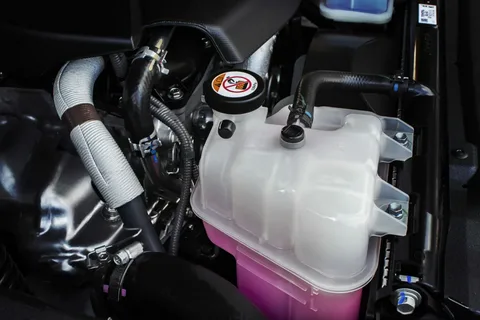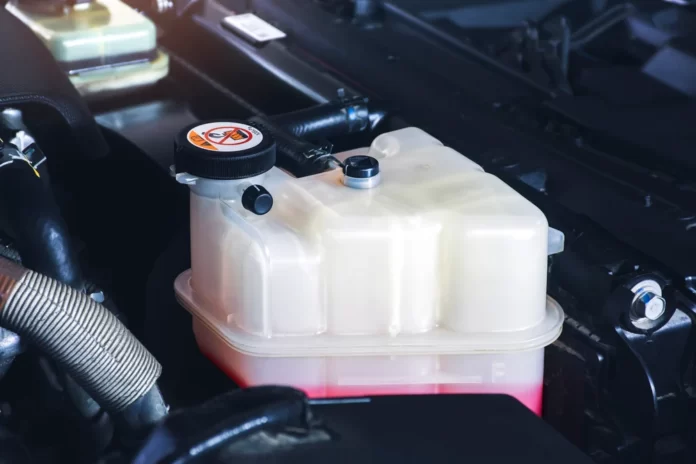Your coolant reservoirs, also known as a coolant recovery system or a coolant tank are an important part of your vehicle. It stores and maintains the liquid that circulates through your engine and keeps it operating at the right temperature. If you notice any leaks or changes in color or consistency of your vehicle’s coolant, you should take it to be checked out by a mechanic before any damage can be done.
Help You Keep Track Of Coolant Levels
The coolant reservoir is a clear container that sits in your engine bay, usually near the front of your vehicle. It’s easy to spot because it has an obvious shape and color, plus it will have either “coolant” or “anti-freeze” written on it.
The purpose of this device is twofold: firstly, it allows you to see how much coolant remains in your system at any given time; secondly, if there isn’t enough liquid left in your car’s cooling system (and therefore no way for heat from within the engine block and cylinder heads to escape), then this can lead directly towards overheating problems–which are bad news for both performance and longevity alike!
You should therefore check regularly whether there are any leaks occurring around this area – as well as refilling if necessary – so as not only keep tabs on what state things are currently in but also prevent future issues arising too early than expected!
Coolant Reservoirs Are Reliable
Coolant Reservoirs are reliable and make sure your engine stays cool. The reservoir is the most important part of your car’s cooling system. It holds a mixture of water and antifreeze, which helps to keep your engine from overheating in hot weather or when you’re driving long distances on the highway.
The reservoir is usually located at the front of your engine, near the radiator. Some cars have them in the engine compartment and others have them under the hood. The reservoir is mounted to a metal bracket and has a cap on top. The cap is usually made of plastic, but some high-performance cars have metal caps. The cap has a small hole in it that allows you to fill the system with coolant or drain it if you need to perform repairs.
Prevent The Loss Of Coolant In Case There Is A Leak
To prevent the loss of your vehicle’s coolant, we recommend checking the reservoir every time you have an oil change or other routine maintenance service performed on your car. If there is a leak in the system, it may be as simple as having one of our technicians add some new fluid to bring back up to proper levels.
If there is no visible sign of any leaks, but you still notice that your temperature gauge has been climbing steadily higher than usual–or if it stays at one level despite driving conditions–it could mean that there’s something wrong with either your radiator cap or thermostat (or both).
Easily Visible So You Can See At A Glance When You Need To Refill
All reservoirs are not created equal. Some are hidden, some are difficult to see, and others are hard to reach or fill.
Visible: The best kind of reservoir is one that’s easy to access and check at a glance so you know when it’s time for a refill. It makes for an easy life as well as peace of mind when it comes to keeping your engine healthy!
Hidden: If you have an older vehicle with an internal combustion engine (ICE), there’s a good chance its cooling system has been designed with only the driver in mind–meaning that there may not be any clear view of the reservoir from outside the car. In these cases, buy an external temperature gauge like this one so that you can keep tabs on how much fluid is left without having to open up every compartment or crawl under seats looking for signs of leakage because nothing else will show up unless there’s something wrong with either part itself or something else nearby which could cause serious damage if allowed unchecked over time.”
They Have A Variety Of Shapes And Sizes To Fit In
The shape and size of your vehicle’s coolant reservoir will vary depending on the make and model. The most common reservoirs are cylindrical, but you may find some that are square or rectangular in shape. The size of the reservoir depends on how much coolant is required for your vehicle, so it will vary from car to truck or SUV. The color of the coolant reservoir will vary depending on the make and model of your vehicle. The most common colors are black, red or blue.
 They Come In Different Materials and Colors
They Come In Different Materials and Colors
You can find reservoirs in a few different materials, including:
Plastic. The most common material for reservoirs is plastic, which makes it easy to install and remove. They also come in many different shapes and sizes to fit your vehicle’s needs.
Aluminum. Aluminum reservoirs are more durable than their plastic counterparts, but they’re heavier, too–which may make them harder to install or remove from the engine block when you need access for maintenance work or repairs (such as replacing an old radiator).
If you’re looking for something that looks great while also doing its job well, look no further than our selection of custom radiator caps!
The Components Are Easily Accessible
If you have a car that uses a coolant reservoir, it’s important to keep an eye on the level. You can easily see how much is in there and add more if necessary. If your car uses one of these reservoirs, the first thing that you’ll want to do when buying coolant is remove it from its housing and check for leaks. If there are no leaks, then go ahead and add new fluid before putting everything back together again.
If you have an open system, then the coolant will flow freely through the system and there will be no reservoir to worry about. You can simply add fluid when needed and take care of any leaks as they occur.
If you have a closed system and you notice that the fluid level is dropping, then it may be time to add more coolant. This can be done by simply unscrewing the cap on top of your reservoir and pouring in some new fluid. If there are any leaks, then they will need to be repaired before adding any more coolant.
It Is a Safety Feature
The coolant reservoir is a safety feature in your vehicle’s health. It will help prevent damage to your car’s engine, which could lead to costly repairs or replacement. The coolant reservoir is easy to install and remove, comes in different materials and colors, and it’s easy to see at a glance when you need to refill.
The coolant reservoir is also a great place to store your vehicle’s emergency kit. It helps keep it dry in case of rain or flooding, and it keeps the contents organized so you can easily access them if needed.
The coolant reservoir is a must-have for anyone who drives a vehicle. Because it’s so important, you should make sure that you get one that fits your needs. There are several different sizes and styles available, so it’s important to choose the one that will best fit your car or truck.
Help Prevent Damage To Your Car’s Engine
When the car’s engine is running, it produces a lot of heat. The coolant reservoir is there to keep that heat from damaging your car’s engine block or overheating it. If you’re a regular driver and don’t take care of your car’s health, this can cause problems in the long run.
The coolant reservoir helps prevent damage by keeping the temperature down so that it doesn’t get too hot in there–and if you do notice something unusual about how hot or cold your car feels when running on the road (or if you see steam coming out from under hood), then this may be an indication that something needs fixing before things get worse!
FAQs
Q: What Is A Coolant Reservoir?
A: The coolant reservoir is a component of your vehicle’s cooling system. It holds the liquid coolant that circulates through your engine to prevent overheating and keep it at optimal operating temperatures.
Q: What Is The Purpose Of A Coolant Reservoir?
A: The purpose of this component is to provide an easy way to add more fluid when needed, so you don’t have to disassemble parts of the engine or remove any hoses from its current position just because they need refilling with new fluid. Having one allows you access at all times without having to do anything too complicated on your own behalf! As long as there’s enough space left inside after filling up with new stuffs, then there shouldn’t be any problems here whatsoever… unless maybe if something happens during operation later down line after installation has been completed successfully.”
Conclusion
The coolant reservoir is a small tank that holds the engine’s coolant. It’s located near the front of the engine and connected to it by hoses. The coolant reservoir contains a mixture of water and ethylene glycol (EG) or propylene glycol (PG). This mixture keeps your engine temperature regulated by absorbing heat from its parts and transferring it into the atmosphere



